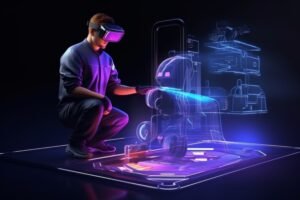
Augmented Reality (AR) and Virtual Reality (VR): Shaping the Future of Mobile App Development
Augmented Reality (AR) and Virtual Reality (VR) are no longer futuristic concepts; they are rapidly transforming the mobile app development landscape. These technologies are poised to redefine how we interact with digital content and offer immersive experiences that were previously unimaginable.
The Rise of AR and VR in Mobile Apps
AR technology overlays virtual elements onto the real world, enhancing user experiences and enabling applications such as virtual try-on for shopping or interactive gaming experiences. VR technology, on the other hand, immerses users in virtual environments, offering opportunities for virtual tours, virtual training, and immersive entertainment experiences.
Real-World Examples of AR and VR in Action
Today, we can find numerous instances where brands utilize AR and VR to enhance user experiences. For example, IKEA employs AR technology to allow users to visualize how furniture will look in their homes before making a purchase. Lenskart offers a virtual try-on feature for glasses, allowing users to see their appearance before buying them.
Tech Giants Leading the Way
Even tech giants like Apple, Google, and Meta are making significant strides in AR and VR. Google introduced a feature called “Live View” in Google Maps, enabling users to view directions in real-time overlaid on the real world through their camera. Another noteworthy advancement in AR technology is LiDAR, which Apple refers to as “AR at the speed of light.” This technology debuted in devices like the iPad Pro, iPhone 12 Pro, and iPhone 12 Pro Max. LiDAR has taken AR to new heights by enabling the capture of high-quality photos even in low-light conditions.
The Future of AR and VR in Mobile App Development
In the coming years, we can anticipate AR and VR to shape the mobile app development industry in ways that surpass our imagination. These technologies will become more mainstream, offering exciting possibilities for developers and users alike.

How to Leverage AR and VR in Your Mobile App Development:
As a mobile app developer, you can leverage AR and VR to create innovative and engaging experiences for your users. Here are some tips:
- Explore the possibilities: Identify how AR and VR can enhance your app’s functionality and user experience.
- Choose the right tools and technologies: Select the appropriate AR and VR development tools and platforms for your project.
- Design for immersive experiences: Create intuitive and engaging user interfaces that are optimized for AR and VR.
- Test and iterate: Thoroughly test your app in AR and VR environments to ensure a seamless and enjoyable user experience.
Tools and Frameworks for AR/VR Mobile Apps
- ARKit (iOS) – Apple’s AR development platform.
- ARCore (Android) – Google’s AR SDK for Android.
- Unity 3D with Vuforia – Popular for cross-platform AR/VR game and app development.
- Unreal Engine – Powerful tool for high-fidelity VR experiences.
- Flutter + Unity/ARKit Plugins – Flutter developers can integrate AR/VR features using native bridges.
Conclusion:-
- AR and VR are rapidly evolving technologies that are poised to transform the mobile app landscape. By embracing these technologies and developing innovative apps that leverage their power, you can create immersive and engaging experiences that will captivate your users.
